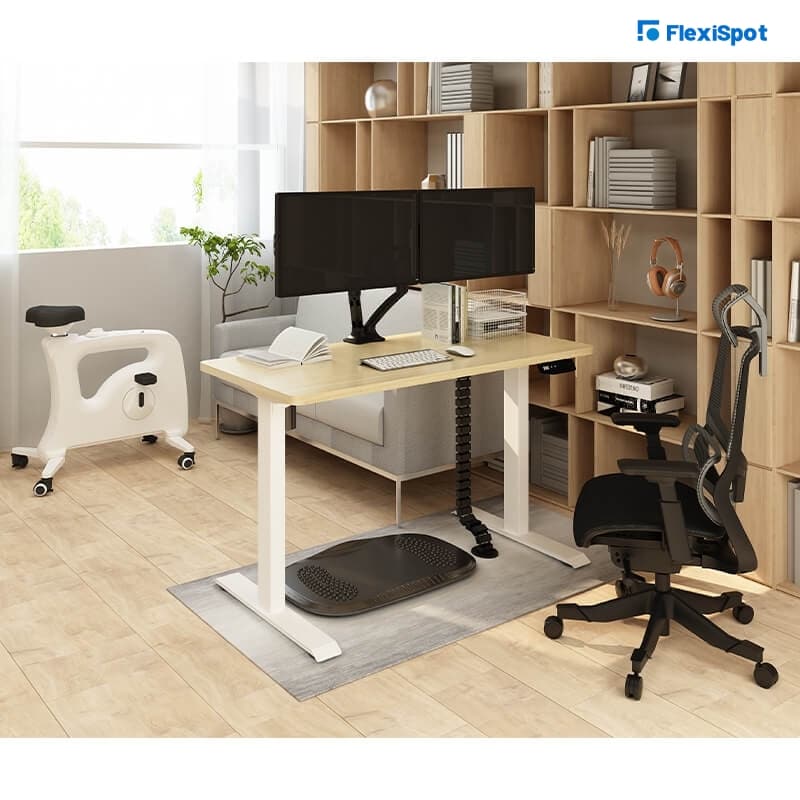Do you often complain about a headache, pain in the neck, shoulders, and eye strain? What do you think is the cause? Most people would say that it's because they work long hours and have to sit in the same position all day long. While that could be one of the reasons, many people don't really realize that ergonomics is a major contributor to your health problems.
Most workplaces have got similar equipment and furniture for all their employees. From standardized furniture design to the same make and model of computers and keyboards, every workstation is identical.
Not many workplaces put a lot of focus on providing each employee with an ergonomic work environment, which can have long-lasting consequences for the employee's health.
This blog post is all about making you understand what an ergonomic environment is and what a non-ergonomic environment can do to your health.
Ergonomic vs. Non-Ergonomic Environment
A non-ergonomic environment, as we said earlier, isn't made to meet the comfort needs of every individual employee. Non-ergonomic environments could be extremely comfortable with comfortable chairs and couches, or they could be the exact opposite with wooden tables and metal chairs. You may find your chair extremely comfortable, but that doesn't mean your colleagues will find it comfortable too. Every individual is different, and the same environment can't be acceptable for everyone.
On the other hand, an ergonomic environment caters to the needs of every employee. The environment is customized to fit all employees. The computer screens are set on the workstation at the eye level of each employee. The chairs feature an adjustable height option so that every employee can adjust the chair's height to a level that's most comfortable to them. The keyboard tray isn't at a fixed height either. You can also adjust the keyboard tray's height as per your preferences. In short, all the aspects of employee comfort are addressed to ensure that the work environment isn't a source of discomfort to anyone.
While most employers are reluctant to invest their money and time into setting up an ergonomic workplace, they should understand that doing things right at the right time will save them money in the long run. Ergonomic environments boost productivity, efficiency, and employee satisfaction, all of which are only going to benefit the business.
Health Risks Associated with Non-Ergonomic Environment
The non-ergonomic environment can lead to so much more than just body pain and tiredness. Working in non-ergonomic environments can have long-term adverse effects on your health. Some of the most worrisome health risks are listed below:
Musculoskeletal Skeletal Disorders
Musculoskeletal disorders, more commonly referred to as MSDs, are extremely painful and debilitating conditions that affect the tendon sheaths, tendons, and nerves which can occur due to working in a non-ergonomic environment for extended hours. One of the most commonly reported MSDs is Carpal Tunnel Syndrome, in which a nerve of the wrist gets pinched, which could lead to unpleasant and uncomfortable symptoms in some and painful symptoms in others. This is mostly due to using non-ergonomic keyboards and office tools. Some common symptoms of Carpal Tunnel Syndrome include sharp pain or tingling sensation and numbness. If you don't address the condition soon, it can lead to serious consequences like partial paralysis or immobility.
Another MSD that you're at risk of developing due to poor posture is tendonitis, a condition in which tendons of the kneecap, elbow, and wrists become inflamed. Bursitis is another MSD that can occur due to working in a non-ergonomic work environment. In this condition, the bursa becomes inflamed as a result of which there are painful swelling in the shoulder area, elbows, or knees.
Back Pain and Injuries
Sitting hunched in front of the computer or bending repeatedly can lead to consistent back pain and even back injuries that can become extremely painful and affect your mobility and day-to-day life. If the employees whose job requires them to sit or stand for extended hours are provided with an ergonomic environment that has got ergonomic chairs, desks like the Electric Height Adjustable Standing Desk , and anti-fatigue mats, the risk of back pain and back injuries can be significantly reduced.
Stiff Neck
If your computer monitor isn't placed at eye level or you've got to bend your neck for long hours, you're highly likely to suffer from a stiff neck. If you're a carpenter who doesn't have an ergonomic workstation or your job requires you to sit in front of a computer screen that isn't appropriately levelled to eye level, you may experience a painful, stiff neck quite often. A stiff neck isn't just painful, but if it gets worse, you might not be able to move or work at all.
Headaches
If you've been suffering from consistent headaches, excessive exposure to computer screens might not be the only factor to blame. It could be due to a non-ergonomic environment. Some of the characteristics of a non-ergonomic environment that could lead to consistent headaches include high glare lighting of the room and computer monitor, non-ergonomic chairs that lead to continuous forward-head sitting position, or non-ergonomic desks which require you to raise your head too much to see the computer screen.
All of these factors can lead to extensive strain on your eyes and stress around the neck and shoulder region, which are some of the most common reasons for headaches and even migraine in most people.
Trigger Fingers
Another health risk that's associated with a non-ergonomic work environment is a condition known as trigger fingers. It's a condition in which the tendon sheaths or tendons in the fingers become inflamed. If your job requires you to type on a keyboard all day long or you've to grip things tightly at your workplace, you're at a higher risk of developing Trigger Fingers. An ergonomic keyboard or ergonomic handles and covers can reduce the risk of Trigger Fingers.
Ganglion Cysts
Ganglion cysts are another health risk of a non-ergonomic environment that you should take seriously. These are pea-sized or larger heard lumps that form in the joint sheaths or joints. Ganglion cysts are most commonly found in the wrists, base of the fingers, or the back of the hand. It's a very painful condition.
If you use a keyboard at work all day long, you're at the highest risk of developing Ganglion cysts. Sometimes, these cysts dissolve on their own, but other times, they remain and cause severe discomfort and pain. Even if you get the cyst removed surgically, they can still return if you continue working in a non-ergonomic environment.
Setting Up an Ergonomic Environment
Your best bet at reducing the health risks associated with a non-ergonomic environment is to modify the environment to make it ergonomic. Some of the ways in which you can create an ergonomic environment are listed below:
Ergonomic Desks and Chairs
One of the most effective ways to create an ergonomic workplace is by investing in ergonomic desks and chairs. You'll come across plenty of options of standing desks with adjustable height options for if your job requires you to stand for long hours, kneeling chairs if you've to work in a bent position, or a work desk with adjustable height so that you can adjust it to suit your height.
Adequate Lighting
Proper lighting is extremely important. The lighting shouldn't be too bright to too dim. If the lighting is too light or too low, it can put excessive stress on the eyes. However, you can reduce this stress by ensuring there's a glare filter on the computer screen to reduce the glare and skylights wherever possible around the workplace.
Set Up a Zone of Frequent Reach
In ergonomics, the zone of frequent reach is the zone where all the things that you use frequently are placed. If the things that you need frequently are placed well within your reach, you won't have to overreach. Overreaching can put stress on your muscles and lead to body pain.
Comfortable Temperature
Another important feature of an ergonomic environment is a comfortable temperature. The temperature of the workplace shouldn't be too cold or too warm. Both extremes can lead to employee discomfort. If the air conditioners are set at low temperatures, the employees may suffer from cold and flu. The employees will sweat profusely and feel irritable if the office space is too warm.
Ergonomics plays an integral role in the productivity and efficiency of employees. The more comfortable they are, the better they'll be able to perform. Investing in setting up an ergonomic workplace will also lead to excellent employee retention in the long run. The non-ergonomic environment is associated with numerous health risks, some of which we've outlined, that can affect the productivity and quality of work. The best way to overcome these ergonomics-related challenges is to invest in ergonomic equipment like ergonomic chairs, standing desks, etc. You'll be surprised at the number of options that are available today.


